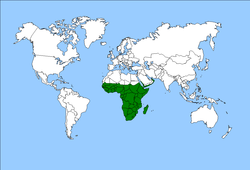Afrotropic
The Afrotropic is one of the Earth's eight ecozones. The zone was formerly known as the Ethiopian Zone.
The zone includes Africa south of the Sahara, the southern and eastern parts of the Arabian Peninsula, the island of Madagascar, southern Iran, extreme southwestern Pakistan, and the islands of the western Indian Ocean. Almost all this land was part of the ancient southern supercontinent of Gondwana, which started to break up 150 million years ago.
Major ecological regions
Because Africa is a very large continent, and runs north/south acrsoss the equator, the zone has many different climates and habitats.
Most of the Afrotropic, has a tropical climate. A broad belt of deserts separate the Afrotropic from the Palearctic ecozone, which includes northern Africa and temperate Eurasia.
Sahel and Sudan
South of the Sahara, two belts of tropical and subtropical grasslands, savannas and shrublands run east and west across the continent, from the Atlantic Ocean to the Ethiopian Highlands.
Immediately south of the Sahara lies the Sahel belt, a transitional zone of semi-arid short grassland and Acacia savanna.
Rainfall increases further south in the Sudan, a belt of taller grasslands and savannas. The Sudanian savanna is home to two great flooded grasslands and savannas, the Sudd wetland in the Sudan, and the Niger Inland Delta in Mali.
Southern Arabian woodlands
South Arabia, mostly Yemen and parts of western Oman and southwest Saudi Arabia, has few permanent forests. Otherwise woodlands scatter the land and are very small Juniper or Acacia forests.
Forest zone
A belt of lowland tropical moist broadleaf forests, runs across most of equatorial Africa.
The largest tropical forest zone in Africa are the forests of the Congo Basin in Central Africa. A belt of tropical moist broadleaf forest also runs along the Indian Ocean coast, from southern Somalia to South Africa.
East Africa
The Great Rift Valley gives East Africa its unique mix of deep lakes, highlands, volcanoes and grassland.
- Acacia-Commiphora grasslands
- Serengeti
- Lake Victoria
- Ngorongoro
- Olduvai Gorge
Southern African
Woodlands, savannas, grasslands and desert.
Madagascar and the Indian Ocean islands
Madagascar and neighboring islands form a distinctive sub-region of the ecozone, with numerous endemic taxa like the lemurs.
Madagascar and the Seychelles are not part of Africa, and that explains why the advanced primates of Africa (monkeys, apes) are not found in Madagascar. This is because Madagascar has not been connected to Africa since the break-up of Gondwana. Lemurs are found occupying more or less the same ecological niches as monkeys do in Africa.
Other Indian ocean islands, like the Comoros and Mascarene Islands, are volcanic islands that formed more recently. Madagascar contains several important biospheres: its biodiversity and numbers of unique species is high.
- Madagascar dry deciduous forests
- Madagascar spiny thickets
- Eastern Madagascar lowland rainforests
Afrotropic Media
African Pygmies living in the Dzanga-Sangha Special Reserve










